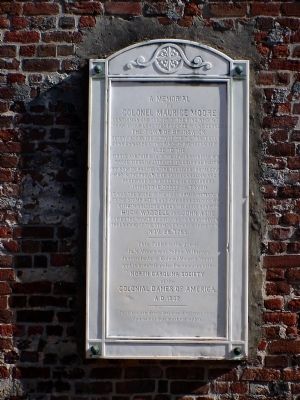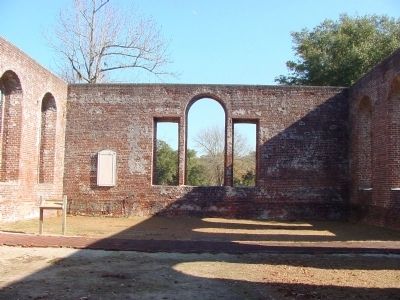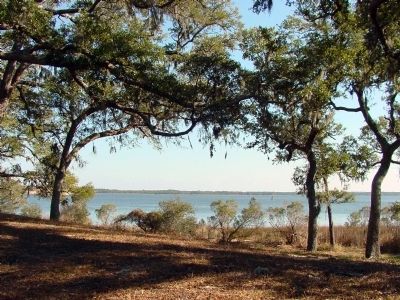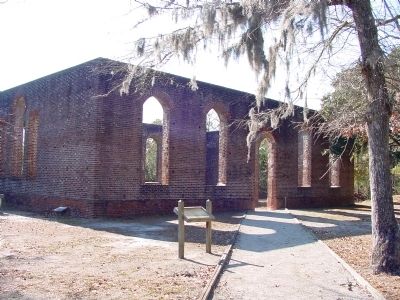Winnabow in Brunswick County, North Carolina — The American South (South Atlantic)
Colonel Maurice Moore
Brunswick was for a time the seat of Royal Government in the Province of North Carolina, and the residence of the colonial governors Johnstone, Dobbs and Tryon. It was the scene of the first armed resistance to the Stamp Act in any American colony, when citizen soldiers under the leadership of Hugh Wadell and John Ashe defied the power of Great Britain and prevented the landing of the stamps from her ships of war, Nov. 28, 1765.
This Tablet is the gift of Ida N. Moore and Selina M. Harvey, descendants of Colonel Maurice Moore and is erected under the auspices of the North Carolina Society of the Colonial Dames of America. A.D. 1902.
For there are deeds that should not pass away, And names that must not wither.
Erected 1902 by the North Carolina Society of the Colonial Dames of America.
Topics and series. This historical marker is listed in these topic lists: Colonial Era • War, US Revolutionary. In addition, it is included in the The Colonial Dames of America, National Society of series list. A significant historical month for this entry is October 1922.
Location. 34° 2.36′ N, 77° 56.805′ W. Marker is in Winnabow, North Carolina, in Brunswick County. Marker can be reached from St. Philips Road. It is in the Brunswick Town Historic Site inside the church ruins. Touch for map. Marker is in this post office area: Winnabow NC 28479, United States of America. Touch for directions.
Other nearby markers. At least 8 other markers are within 2 miles of this marker, measured as the crow flies. Fort Anderson (here, next to this marker); John LaPierre (within shouting distance of this marker); a different marker also named Fort Anderson (within shouting distance of this marker); Brunswick Town State Historic Site (within shouting distance of this marker); Russelborough (approx. 0.4 miles away); Russellborough (approx. 0.4 miles away); Orton Plantation (approx. 1.7 miles away); St. Philips Church (approx. 2 miles away). Touch for a list and map of all markers in Winnabow.
More about this marker. Tablet was affixed to the inside wall of the St. Philips Church ruins. All four walls of the church are standing and
in good repair, but there are no roof, windows or doors.
Regarding Colonel Maurice Moore. “When [George] Burrington came over as governor, in January, 1724, he was persuaded to ignore the directions of the Lords Proprietors forbidding lands to be granted on the Cape Fear, and [Maurice] Moore made a settlement on that river, in which he was joined by his brothers, Roger and Nathaniel, from South Carolina, and by his family connections both in South Carolina and from the Albemarle and Pamlico. He laid off and established in 1725 the town of Brunswick, about fifteen miles from the mouth of the Cape Fear, all that region being then embraced within the territory of Carteret Precinct, which extended to the southern limits of the province. Governor Burrington fostered this new settlement, and himself took up lands on the Cape Fear, where he established two plantations. The new colony prospered greatly from the first; but when Burrington came in as a royal governor, in 1731, his political disputes led to personal antagonisms, and becoming opposed to Moore, he sought to establish another town higher up the river in opposition to Brunswick, but without avail. However, his successor, Governor Johnston, purchased lands and became interested in the new settlement, then called Newton, which he later named Wilmington, and which he proposed to foster by every means at the expense of Brunswick. Within six months after his arrival he appointed courts to be held at Newton on the 13th of May, 1735, and designated Newton as a place for receiving quit-rents, and otherwise sought to make that place the seat of government for that part of the province. This antagonism of the interests centered in Brunswick led to much animosity, and Moore and his connections, who, because of their great wealth and powerful influence, gave the governor in his administration much trouble, were referred to by the governor’s friends as ‘the family.’ The controversies raised on either side embroiled the entire province, until at length the governor made a compromise in 1740, and about that time Roger Moore, Edward Moseley and Eleazar Allen, who were friends and connections of Colonel Moore, became members of the Council.
“Colonel Moore was a strong man, and being a brother-in-law of Edward Moseley and stepfather of Sam Swann and of John Baptista Ashe, he was a directing influence in the affairs of the province. He was speaker of the Assembly of 1725, and was always a member of that body, and was in entire co-operation with those who controlled popular action among the people and gave direction to public affairs, and in all the controversies, from the purchase of the province by the Crown until his death in 1743, he was a moving spirit in securing the constitutional rights of the people.
“While Colonel Moore was largely interested on the lower Cape Fear, his principal plantation was at Rocky Point, where he resided toward the close of his life and was buried.” —Taken from the 1905 book Biographical History of North Carolina from Colonial Times to the Present by Samuel A’Court Ashe.
Additional commentary.
1. ...And Names That Must Not Wither...
The closing verses on this marker are taken from the third canto of the epic poem “Childe Harold’s Pilgrimage” by George Gordon, Lord Byron (1788–1824). Stanza 640 reads,
But these are deeds which should not pass away,
And names that must not wither, though the earth
Forgets her empires with a just decay,
The enslavers and the enslaved, their death and birth;
The high, the mountain-majesty of worth
Should be, and shall, survivor of its woe,
And from its immortality look forth
In the sun’s face, like yonder Alpine snow,
Imperishably pure beyond all things below.
— Submitted March 23, 2008, by J. J. Prats of Powell, Ohio.
Credits. This page was last revised on June 16, 2016. It was originally submitted on March 23, 2008, by J. J. Prats of Powell, Ohio. This page has been viewed 3,453 times since then and 33 times this year. Photos: 1, 2, 3, 4. submitted on March 23, 2008, by J. J. Prats of Powell, Ohio.



